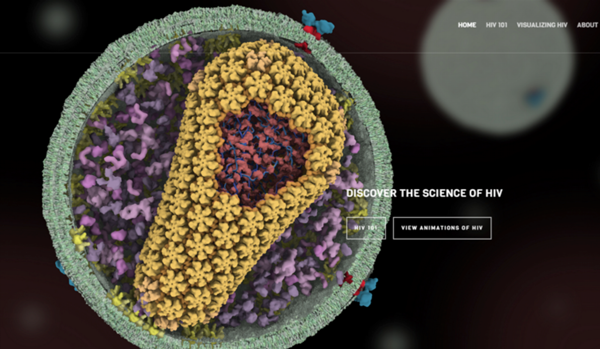Acquired immune deficiency syndrome, or AIDS, is a disease that is caused by the human immunodeficiency virus (HIV). Although we currently have treatments to keep HIV from ever progressing to AIDS, we do not yet have a cure. Thanks to public awareness efforts, it is likely that many, if not most of the adults in the US are familiar with these sobering facts about HIV.
What may be less visible to the public is the fact that intensive research efforts over the past three decades have given us an increasingly clear picture of how HIV infects our cells, down to the scale of molecules. Part of the difficulty in relaying this information to the public is that molecular-scale events can be hard to teach, particularly in informal settings. Even the most passionate of learners can quickly become overwhelmed by scientific jargon and the abstractness of molecular topics. Molecular animations, however, can help bridge this gap by making complex biological concepts more accessible to broad audiences.
With these thoughts in mind, I launched the Science of HIV project. The goal of the project is to create scientifically accurate and visually stunning visualizations of the HIV life cycle, highlighting the findings of HIV researchers, and particularly focusing on structural biology efforts. This work is being completed with support from the NIGMS Specialized Centers for HIV/AIDS-Related Structural Biology, and, in particular, CHEETAH (The Center for the Structural Biology of Cellular Host Elements in Egress, Trafficking, and Assembly of HIV) based at the University of Utah.

The current Science of HIV website (scienceofHIV.org).
To showcase the HIV life cycle animations, I launched a multimedia-rich website (scienceofHIV.org). The full life cycle animation is not yet complete, but different stages of the life cycle, including entry (how the virus gets into cells) and maturation (a series of changes that a newly formed virus undergoes in order to become infectious) are currently available to view in draft form. I've also created an animation showing the molecular mechanism by which old world monkeys are thought to block infection by HIV-1 (the form of the virus that infects humans). Over the next couple of years, I will be completing additional segments covering other portions of the life cycle, as well as animations showing how therapeutics (both current and future) work. When complete, the different animation pieces will be glued together to make a complete life cycle animation, which will probably be between 5-10 minutes in length. The animation will feature music and narration, and will be freely available for anyone to watch and download.
One important thing to note is that, despite our increasing understanding of how HIV operates, there are many topics that are very active areas of research, and where we are still making major discoveries. By their nature, molecular animations show a great amount of detail — very often showing more than researchers actually have hard data for. For this reason, I consider these molecular animations to be a sort of visual hypothesis — a way of showing how my collaborators think that a particular process happens. In many cases, researchers will not agree on one mechanism, and may be actively doing research in the lab to test between one or more possibilities. In these cases, the life cycle animation may offer one or more alternative views of a process.
The video illustrates the virus entry as part of the HIV lifecycle animation. Learn more at http://scienceofhiv.org/wp/?portfolio=hiv-entry
In addition to hosting animations, the Science of HIV website will offer a narrative description of what is shown in the animation, including links to PDB structures that have been used and references to journal articles.
The HIV 101 section provides a general overview of HIV and AIDS, and how antiretroviral therapies work. This section will also soon feature a 2D animation created in collaboration with TED Ed about why HIV has been so difficult to cure.
Future planned features of the website include:Please get in touch if you have additional ideas of additional features you'd like to see!
The animation shows the molecular mechanism by which old world monkeys are thought to block infection by HIV-1. Learn more at http://scienceofhiv.org/wp/?portfolio=blocking-infection-trim5-alpha
The video shows an early draft animation depicting maturation, and focusing on the encapsulation of RNA and nucleocapsid protein by the growing capsid shell. Learn more at http://scienceofhiv.org/wp/?portfolio=hiv-maturation-early-draft